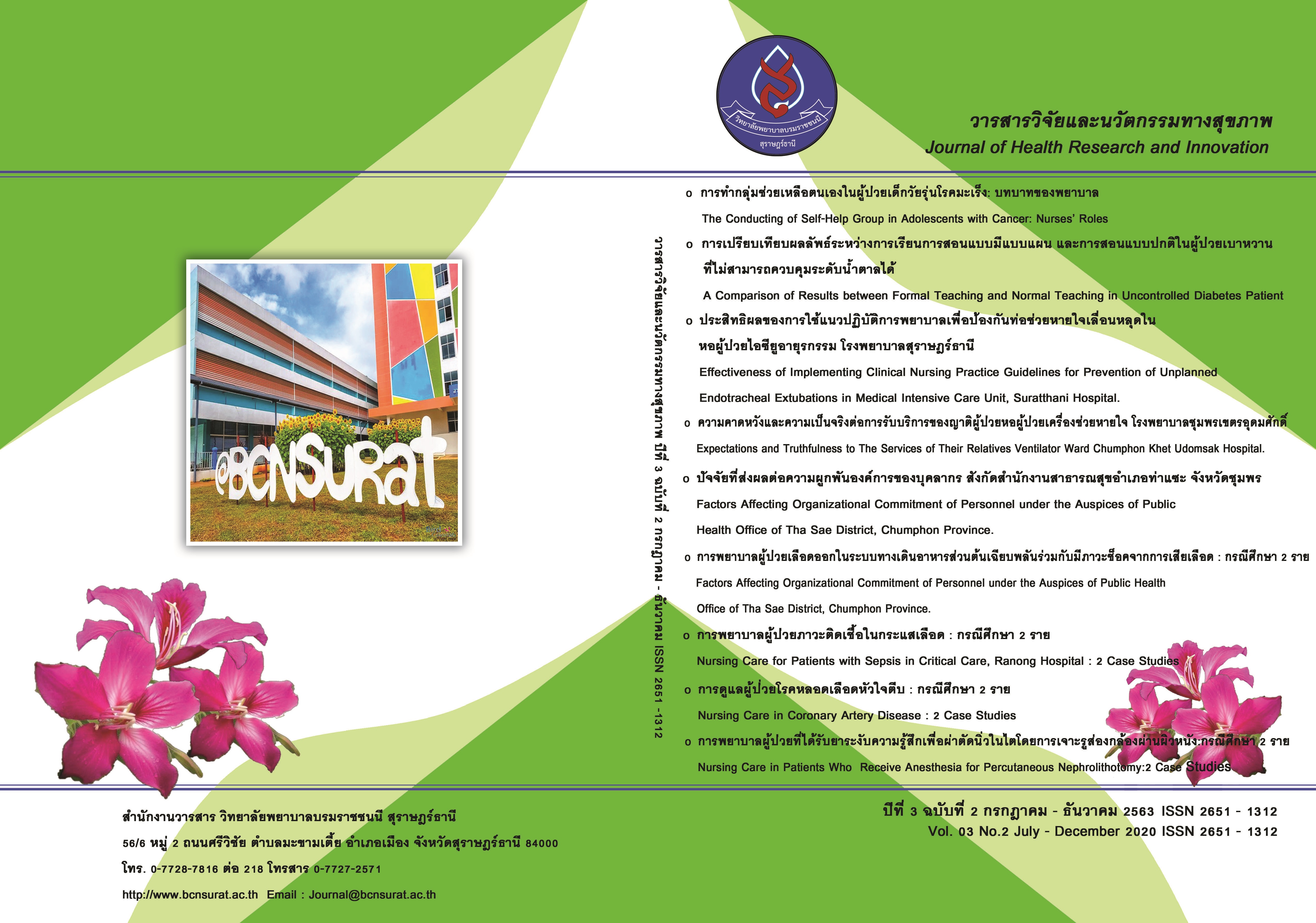ประสิทธิผลของการใช้แนวปฏิบัติการพยาบาลเพื่อป้องกันท่อช่วยหายใจ เลื่อนหลุดในหอผู้ป่วยไอซียูอายุรกรรม โรงพยาบาลสุราษฎร์ธานี
คำสำคัญ:
แนวปฏิบัติการพยาบาล, การเกิดท่อช่วยหายใจเลื่อนหลุด, ความพึงพอใจของพยาบาลวิชาชีพบทคัดย่อ
การเกิดท่อช่วยหายใจเลื่อนหลุดเป็นภาวะแทรกซ้อนที่พบได้บ่อยในผู้ป่วยวิกฤตและเป็นภาวะคุกคามต่อชีวิต การป้องกันท่อช่วยหายใจเลื่อนหลุดจำเป็นต้องปฏิบัติตามแนวปฏิบัติเพื่อให้เกิดผลลัพธ์ที่พึงประสงค์ การศึกษาเชิงปฏิบัติการครั้งนี้เป็นการศึกษาประสิทธิผลของการใช้แนวปฏิบัติการพยาบาลเพื่อป้องกันท่อช่วยหายใจเลื่อนหลุดในหอผู้ป่วยไอซียูอายุรกรรม 1 โรงพยาบาล
สุราษฎร์ธานี จังหวัดสุราษฎร์ธานี และความพึงพอใจของพยาบาลผู้ใช้แนวปฏิบัติ ประชากรกลุ่มเป้าหมาย คือ ผู้ป่วยทุกรายที่มารับบริการในหอผู้ป่วยไอซียูอายุรกรรม 1 ที่ได้รับการใส่คาท่อช่วยหายใจทางปาก โดยแบ่งกลุ่มตัวอย่างเป็น 2 กลุ่ม คือ กลุ่มที่มารับบริการก่อนมีการใช้แนวปฏิบัติการพยาบาล จำนวน 80 คน และกลุ่มที่มารับบริการระหว่างมีการใช้แนวปฏิบัติการพยาบาล จำนวน 96 คน เครื่องมือที่ใช้ในการศึกษา คือ แนวปฏิบัติการพยาบาลเพื่อป้องกันท่อช่วยหายใจเลื่อนหลุด ประกอบด้วยสาระสำคัญ 2 หมวด ได้แก่ หมวดที่1 การประเมินความเสี่ยงของการเกิดท่อช่วยหายใจเลื่อนหลุด และ หมวดที่ 2 ปฏิบัติการพยาบาลเพื่อป้องกันท่อช่วยหายใจเลื่อนหลุดประกอบด้วย 7 กิจกรรม ได้แก่ 1) การให้ข้อมูล 2) การสื่อสารที่มีประสิทธิภาพ 3) การดูดเสมหะในท่อช่วยหายใจ 4) การยึดตรึงท่อช่วยหายใจให้มีประสิทธิภาพ 5) การใช้แนวปฏิบัติในการหย่าเครื่องช่วยหายใจ 6) การประเมินความปวดและจัดการความปวด 7) การผูกยึดร่างกายที่เหมาะสม
ผลการศึกษาพบว่ากลุ่มตัวอย่างที่มารับบริการระหว่างมีการใช้แนวปฏิบัติการพยาบาล มีอุบัติการณ์การเกิดท่อช่วยหายใจเลื่อนหลุด 7.52 ครั้ง /1,000วันคาท่อช่วยหายใจ ซึ่งน้อยกว่ากลุ่มตัวอย่างที่มารับบริการก่อนมีการใช้แนวปฏิบัติการพยาบาลที่มีอุบัติการณ์การเกิดท่อช่วยหายใจเลื่อนหลุด 11.90 ครั้ง /1,000 วันคาท่อช่วยหายใจ แสดงให้เห็นว่าการใช้แนวปฏิบัติการพยาบาลเพื่อป้องกันท่อช่วยหายใจเลื่อนหลุดสามารถลดอุบัติการณ์การเกิดท่อช่วยหายใจเลื่อนหลุดได้ ดังนั้นควรนำแนวปฏิบัติการพยาบาลนี้ไปใช้ในการพัฒนาคุณภาพการดูแลผู้ป่วยวิกฤตที่ใส่ท่อช่วยหายใจต่อไป
คำสำคัญ : แนวปฏิบัติการพยาบาล, การเกิดท่อช่วยหายใจเลื่อนหลุด, ความพึงพอใจของพยาบาลวิชาชีพ
เอกสารอ้างอิง
care unit : A nine-year retrospective analysis, 89(7):25-31.
Bangaorn, N., Ampaporn, N., & Nam-oy, P. (2015). Unplanned extubation and duration of
mechanical ventilation in critical ill patients on evidenced based nursing practice.
Kuakarun journal of nursing, 22(1):129-143. (in Thai).
Chang, LY., Wang, KK., & Chao, YE. (2008). Influence of physical restraint on unplanned
extubation of adult intensive care patients : a case control study. American Journal
Critical care,17(5)408-15.
Jarachovic, M., Mason, M., Kerber, K., & McNett, M. (2011). The role of standardized
protocols in unplanned extubations in a medical intensive care unit. American
Journal Critical care, 20(4):304-11.
Keikkas, P., Aretha, D., Panteli, E., & Baltopoulos, G. (2013). Unplanned extubation in
critically ill adults : Clinical review. Nursing in critical care, 18(3) : 123-134.
Maneenuch, S., Kanittha, K., & Wassana, N. (2017). Effects of utilizing clinical nursing
practice guide on the incident of unplanned extubation in critical ill patients. Journal
of nursing and education,1(2) 58-70. (in Thai).
Napassaporn, D. (2011). Effectiveness of implementing clinical practice guidelines for
prevention of unplanned endotracheal extubations in medical intensive care unit,
Lampang hospital. Thesis of master of nursing science (adult nursing). Chaing mai
University. (in Thai).
Somchit, S. (2012). The development and evaluation of clinical nursing practice guideline for
preventing unplanned extubation in surgical intensive care unit. Thesis of master of
nursing science (adult nursing), Prince of Songkla University. (in Thai).
Silva, PS., & Fonseca, MC. (2012). Unplanned endotracheal extubations in the intensive
care unit : systematic review, critical appraisal and evidence-based
recommendations. Anesthesia and analgesia, 114(5):1003-14.
Sirata, C. (2007) The development of a clinical nursing practice guideline to prevent self
extubation in critical adult patients (master thesis) Mahidol university.(in Thai).
Tanios, M., Epstein, S., Grzeskowiak, M., Nguyen, M., Park, H., & Leo, J. (2014) Influence of
sedation strategies on unplanned extubation in a mixed intensive care unit. Journal
of critical care, 23:306-15
Tanios, MA., Epstein, SK., Livelo, J., & Teres D. (2010) Can we identify patients at high risk
for unplanned extubation? a large-scale multidisciplinary survey. Respiratory care,
55(5):561-8.
Thongplew, K., Manaporn, C., Ampaporn, N., & Unchalee, Y. (2011). Effect of nursing
system development in using evidence-base protocol on quality of care in patients
with ventilator in intensive care unit, Singburi hospital. Joural of nurses association
of Thailand,north-eastern division, 29(2):25-34.(in Thai).
Wiparat, N., Panomporn, P., Parichart, S., Pathumporn, K., & Suweena, B.(2017). Effect of
PMK unplanned extubation prevention program on extubation rate in medical
wards, Phramongkutklao hospital. Journal of the royal thai army nurses, 18(1) 167-175. (in Thai).
Yeh, SH., Lee, LN., Ho, TH., Chiang TH, & Lin, LW. (2004) Implication of nursing care in the
occurrence and consequences of unplanned extubation in adult intensive care
unit. 41(3):255-62.
ดาวน์โหลด
เผยแพร่แล้ว
รูปแบบการอ้างอิง
ฉบับ
ประเภทบทความ
สัญญาอนุญาต
บทความที่ได้รับการตีพิมพ์เป็นลิขสิทธิ์ของวารสารวิทยาลัยพยาบาลบรมราชชนนี สุราษฎร์ธานี
ข้อความที่ปรากฏในบทความแต่ละเรื่องในวารสารวิชาการนี้เป็นความคิดเห็นส่วนตัวของผู้เขียนแต่ละท่านไม่เกี่ยวข้องกับวิทยาลัยพยาบาลบรมราชชนนี สุราษฎร์ธานี และคณาจารย์ท่านอื่นๆในวิทยาลัยฯ แต่อย่างใด ความรับผิดชอบองค์ประกอบทั้งหมดของบทความแต่ละเรื่องเป็นของผู้เขียนแต่ละท่าน หากมีความผิดพลาดใดๆ ผู้เขียนแต่ละท่านจะรับผิดชอบบทความของตนเองแต่ผู้เดียว



